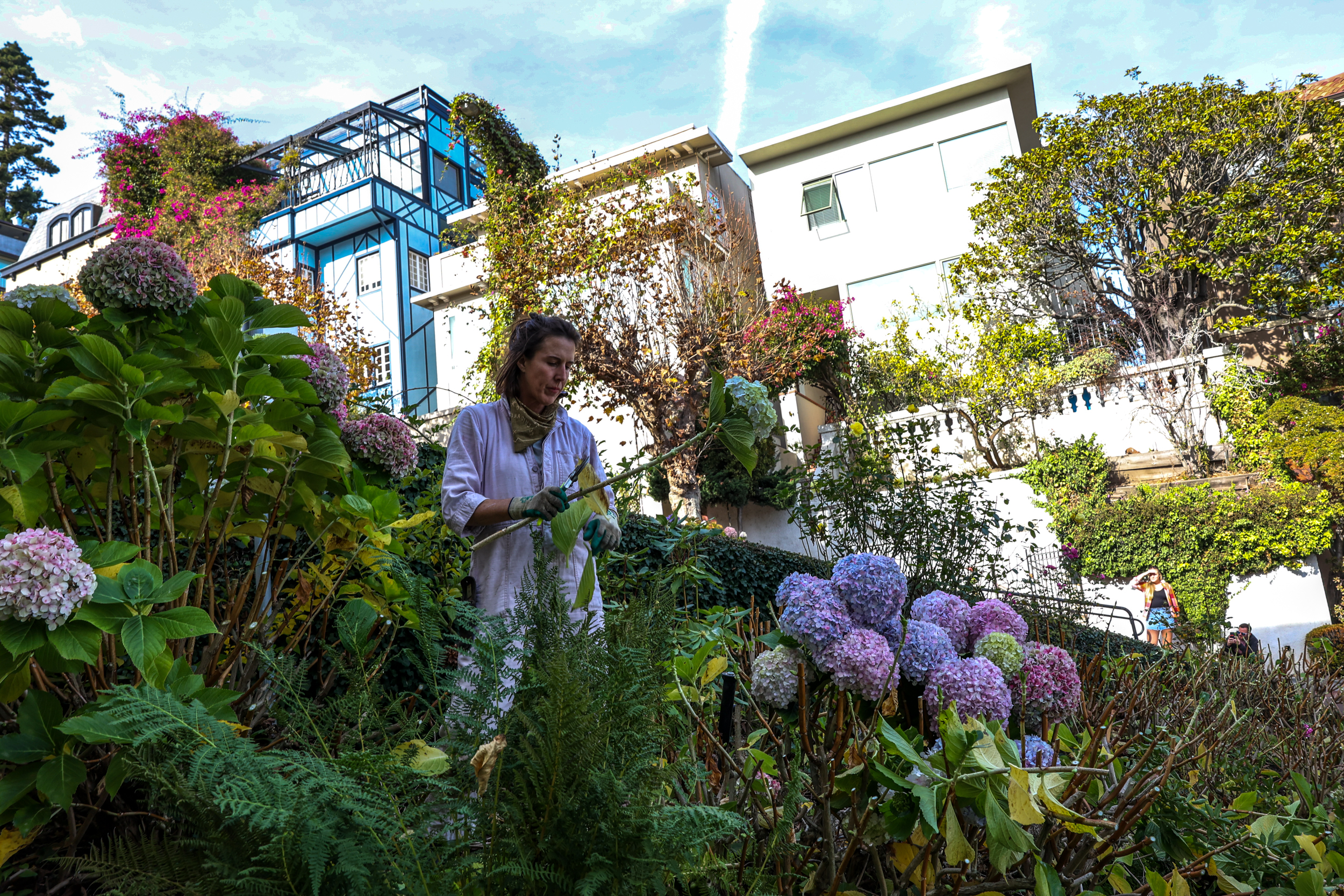Lombard Street is famous for its steep, crooked right-of-way, paved with red brick and offering an impossibly gorgeous view of Telegraph Hill. Or, rather, the block of it between Hyde and Leavenworth streets is. Most city residents experience Lombard via its flatter, longer section, a traffic-clogged quasi-expressway en route to the Golden Gate Bridge.
But the curvy block of Lombard, beloved by visitors from the world over, has another quirk: The twisting roadbed creates 10 tiered flower beds, each filled with meticulous plantings. They may look as though a team of gardeners maintains them, but in fact, one person handles it all. Jenny Board, on behalf of the Lombard Hill Improvement Association, has tended to the hydrangeas, tea roses and Matilija poppies for the last 11 years—and she essentially has carte blanche.
“They give me the money, and they let me do what I want with it,” she told The Standard, taking a break from pruning back the hydrangeas for the winter. “But I take very personally the input from the folks who live here. People not just on the block but the surrounding areas are attached to the old-school gardens on Lombard Street.”
@sfstandard For 11 years, Jenny Board has been the sole gardener for San Francisco’s iconic Lombard Street, curating the landscape and caring for its historic hydrangeas. When was the last time you took a drive through this landmark? #sf #sanfrancisco #sflandmark #lombardstreet #sfhistory #sfstandard #tiktok #fyp
♬ Garden - 3scope
Board lived near Coit Tower until her family bought a home in Marin last year. These days, she works on the flower beds about 25 to 30 hours a week, creating 8-foot piles of yard waste and debris that she hopes the crews who care for the street trees will help cart away. Lately, she’s been deadheading hydrangeas, because years of drought, plus a largely fogless summer, left them stressed.
“Hydrangeas need a real deep saturation of water,” Board said. “They burn really easily. In areas where we have no shade, they struggle.”
The roses, though, are thriving—even at the end of November.
“I planted about 40, and some are doing well,” Board said. “They’re leggy, but they’re hanging in there. I planted them all on the backs of each bed, so that they pop up when people drive down.”
Late fall is one of her favorite times of year, when the beds are largely dormant and everything’s starting to get ready for the growing season—which starts well before March 21. (Ask almost any California gardener, and they will tell you the same thing: This state is one season ahead.)
As the flowers die back, the 14 sycamores on the north side of the street become more prominent. They’ve been “pollarded,” or pruned to a haunted, knobby shape, like the trees opposite City Hall.
“It’s kind of a way of training them to promote growth in the spring, and they look cool,” Board said. “In the winter, when they’re bald and they’re cut back, they’re kind of like these abstract figures creating this shape in the garden.”
Although Lombard’s curves are largely regular, each of the 10 flower beds is unique. You might think that a hill with limited sightlines and hundreds of out-of-town drivers looking elsewhere would constitute a hazardous workplace. Board said that’s not so.
“A lot of the tourists are white-knuckling it,” she said. “They can be more sensitive to the grade. Some of the locals are so comfortable driving on the slope, but luckily, no major near-misses.”
After more than a decade, a few heavily involved residents have passed away, so money is something of an issue. Board is working with Supervisor Aaron Peskin’s office to secure funds to upgrade the antiquated irrigation system, and contributions from visitors haven’t made up all of the difference.
Her garden gets plenty of voluntary help, though—if in the unwanted, horticultural sense.
“I get a lot of ‘volunteers,’” Board said. “Seeds, tree sprouts. The beds at the top of the hill are really hit with weeds, because it’s the first stop for anything that blows up over Lombard. It’s kind of a microclimate, even on the crooked street.”
